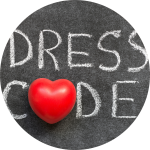
Establishing the appropriate office dress code is no longer a basic task. Today, acceptable business attire is largely determined by business industry, the client base served, and expectations for remote workers. Standard business attire can be defined by five basic categories; Business Professional, Business Casual, Smart Casual, Casual and Remote.
Business Professional is best known as traditional attire such as a suit and tie. This dress code is characterized as conservative and is most often seen in government, law and financial offices. Attire includes pant suits or skirt suits where the jacket and pants/skirt match. Button down-shirts, tucked-in, and enclosed dress shoes. A necktie or bowtie for men, and a simple accessory for women such as a necklace or brooch. This dress code is all about simplicity, classic instead of trendy, clean and simple.
Business Casual is attire that is polished, but a bit more comfortable and relaxed compared to Business Professional. Business casual is most often seen at media and marketing firms, non profit organizations and in education settings. This is the most common dress code for today’s workforce. Like Business Professional, this dress code is simple but has a wider range of options including dress pants or skirts, dresses, shirts and sweaters, neckties (optional) and enclosed shoes such as loafers and flats. Business casual clothing has many bonuses as the clothing options can be incorporated into other wardrobe areas.
Smart Casual is becoming an increasingly popular office dress code category. Tech companies are the most common Smart Casual workplaces. This relaxed look is more about comfort and functionality and is, for the most part, about individuality. Smart Casual work environments may not even have a formal dress code policy in place. While the Smart Casual workplace is informal, the general clothing range includes dark jeans or casual pants, dresses and skirts, untucked shirts, casual sweaters and nice shoes, which may even include sneakers. There aren’t a lot of rules for Smart Casual but clothing should still be neat, clean, properly fitted and modest.
Casual attire is exactly that, casual-come-as-you-are clothing that is comfortable and easy to wear. Small businesses, tech companies and the arts are most commonly casual. Casual can mean different things to different people so it’s important to define the boundaries for this dress code. Most commonly, casual workplace dress codes include jeans or casual pants, dresses and skirts, t-shirts and comfortable shoes. Clothing should still we well-fitting and clean.
Remote – Video Conference Call dress codes are becoming increasingly necessary. It can be tricky figuring out what is appropriate to wear for a meeting while working from home. There’s no harm in establishing standards and expectations for remote employees. It’s important to dress “Meeting-Appropriate.” In other words, an important meeting with a client or CEO may dictate Business Professional attire whereas a team meeting may be more Business Casual. The best rule is to dress up as opposed to dressing down, keep colors neutral and patterns simple. Clothing should also be well-fitting to look the best while on screen.
Whatever the office environment, it is important to have a company dress code policy in place. This policy is best reviewed during the hiring and onboarding processes and incorporated into the Employee Handbook for reference by both employees and management.
*Southland Data Processing, Inc. (“SDP”) is not a law firm. This article is intended for informational purposes only and should not be relied upon in reaching a conclusion in a particular area of law. Applicability of the legal principles discussed may differ substantially in individual situations. Receipt of this or any other SDP materials does not create an attorney-client relationship. SDP is not responsible for any inadvertent errors that may occur in the publishing process.
